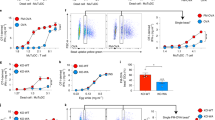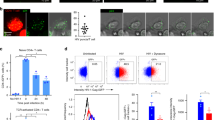Abstract
Cross-presentation of cell-associated antigens plays an important role in regulating CD8+ T cell responses to proteins that are not expressed by antigen-presenting cells (APCs)1. Dendritic cells are the principal cross-presenting APCs in vivo and much progress has been made in elucidating the pathways that allow dendritic cells to capture and process cellular material1. However, little is known about the signals that determine whether such presentation ultimately results in a cytotoxic T cell (CTL) response (cross-priming) or in CD8+ T cell inactivation (cross-tolerance). Here we describe a mechanism that promotes cross-priming during viral infections. We show that murine CD8α+ dendritic cells are activated by double-stranded (ds)RNA present in virally infected cells but absent from uninfected cells. Dendritic cell activation requires phagocytosis of infected material, followed by signalling through the dsRNA receptor, toll-like receptor 3 (TLR3). Immunization with virus-infected cells or cells containing synthetic dsRNA leads to a striking increase in CTL cross-priming against cell-associated antigens, which is largely dependent on TLR3 expression by antigen-presenting cells. Thus, TLR3 may have evolved to permit cross-priming of CTLs against viruses that do not directly infect dendritic cells.
This is a preview of subscription content, access via your institution
Access options
Subscribe to this journal
Receive 51 print issues and online access
$199.00 per year
only $3.90 per issue
Buy this article
- Purchase on Springer Link
- Instant access to full article PDF
Prices may be subject to local taxes which are calculated during checkout




Similar content being viewed by others
References
Heath, W. R. et al. Cross-presentation, dendritic cell subsets, and the generation of immunity to cellular antigens. Immunol. Rev. 199, 9–26 (2004)
Fonteneau, J. F. et al. Activation of influenza virus-specific CD4 + and CD8 + T cells: a new role for plasmacytoid dendritic cells in adaptive immunity. Blood 101, 3520–3526 (2003)
Salio, M., Palmowski, M. J., Atzberger, A., Hermans, I. F. & Cerundolo, V. CpG-matured murine plasmacytoid dendritic cells are capable of in vivo priming of functional CD8 T cell responses to endogenous but not exogenous antigens. J. Exp. Med. 199, 567–579 (2004)
Allan, R. S. et al. Epidermal viral immunity induced by CD8alpha + dendritic cells but not by Langerhans cells. Science 301, 1925–1928 (2003)
Smith, C. M. et al. Cutting edge: conventional CD8alpha(+ ) dendritic cells are preferentially involved in CTL priming after footpad infection with herpes simplex virus-1. J. Immunol. 170, 4437–4440 (2003)
Belz, G. T. et al. Cutting edge: conventional CD8alpha(+ ) dendritic cells are generally involved in priming CTL immunity to viruses. J. Immunol. 172, 1996–2000 (2004)
den Haan, J. M., Lehar, S. M. & Bevan, M. J. CD8(+ ) but not CD8(-) dendritic cells cross-prime cytotoxic T cells in vivo. J. Exp. Med. 192, 1685–1696 (2000)
Valdez, Y. et al. Major histocompatibility complex class II presentation of cell-associated antigen is mediated by CD8alpha + dendritic cells in vivo. J. Exp. Med. 195, 683–694 (2002)
Iyoda, T. et al. The CD8(+ ) dendritic cell subset selectively endocytoses dying cells in culture and in vivo. J. Exp. Med. 195, 1289–1302 (2002)
Schulz, O. & Reis e Sousa, C. Cross-presentation of cell-associated antigens by CD8α+ dendritic cells is attributable to their ability to internalise dead cells. Immunology 107, 183–189 (2002)
Belz, G. T. et al. The CD8alpha(+ ) dendritic cell is responsible for inducing peripheral self-tolerance to tissue-associated antigens. J. Exp. Med. 196, 1099–1104 (2002)
Liu, K. et al. Immune tolerance after delivery of dying cells to dendritic cells in situ. J. Exp. Med. 196, 1091–1097 (2002)
Le Bon, A. et al. Cross-priming of CD8 + T cells stimulated by virus-induced type I interferon. Nature Immunol. 4, 1009–1015 (2003)
Alexopoulou, L., Holt, A. C., Medzhitov, R. & Flavell, R. A. Recognition of double-stranded RNA and activation of NF-kappaB by Toll-like receptor 3. Nature 413, 732–738 (2001)
Edwards, A. D. et al. Toll-like receptor expression in murine DC subsets: lack of TLR7 expression by CD8α+ DC correlates with unresponsiveness to imidazoquinolines. Eur. J. Immunol. 33, 827–833 (2003)
Kaufman, R. J. Double-stranded RNA-activated protein kinase mediates virus-induced apoptosis: a new role for an old actor. Proc. Natl Acad. Sci. USA 96, 11693–11695 (1999)
Harshyne, L. A., Watkins, S. C., Gambotto, A. & Barratt-Boyes, S. M. Dendritic cells acquire antigens from live cells for cross-presentation to CTL. J. Immunol. 166, 3717–3723 (2001)
Helwig, F. & Schmidt, E. A filter-passing agent producing interstitial myocarditis in anthropoid apes and small animals. Science 102, 31–33 (1945)
Strauss, J. H. & Strauss, E. G. The alphaviruses: gene expression, replication, and evolution. Microbiol. Rev. 58, 491–562 (1994)
Smerdou, C. & Liljestrom, P. Two-helper RNA system for production of recombinant Semliki forest virus particles. J. Virol. 73, 1092–1098 (1999)
Diebold, S. S. et al. Viral infection switches non-plasmacytoid dendritic cells into high interferon producers. Nature 424, 324–328 (2003)
Freigang, S., Egger, D., Bienz, K., Hengartner, H. & Zinkernagel, R. M. Endogenous neosynthesis vs. cross-presentation of viral antigens for cytotoxic T cell priming. Proc. Natl Acad. Sci. USA 100, 13477–13482 (2003)
Edelmann, K. H. et al. Does Toll-like receptor 3 play a biological role in virus infections? Virology 322, 231–238 (2004)
Crozat, K. & Beutler, B. TLR7: A new sensor of viral infection. Proc. Natl Acad. Sci. USA 101, 6835–6836 (2004)
Muzio, M. et al. Differential expression and regulation of toll-like receptors (TLR) in human leukocytes: selective expression of TLR3 in dendritic cells. J. Immunol. 164, 5998–6004 (2000)
Tabeta, K. et al. Toll-like receptors 9 and 3 as essential components of innate immune defense against mouse cytomegalovirus infection. Proc. Natl Acad. Sci. USA 101, 3516–3521 (2004)
Melief, C. J. Regulation of cytotoxic T lymphocyte responses by dendritic cells: peaceful coexistence of cross-priming and direct priming? Eur. J. Immunol. 33, 2645–2654 (2003)
Reis e Sousa, C. Toll-like receptors and dendritic cells: for whom the bug tolls. Semin. Immunol. 16, 27–34 (2004)
Hoebe, K. & Beutler, B. LPS, dsRNA and the interferon bridge to adaptive immune responses: Trif, Tram, and other TIR adaptor proteins. J. Endotoxin Res. 10, 130–136 (2004)
Katze, M. G., He, Y. & Gale, M. Viruses and interferon: A fight for supremacy. Nature Rev. Immunol. 2, 675–687 (2002)
Acknowledgements
This work was funded by Cancer Research UK (C.R.S.) and by the Swedish Research Council and the EU program (P.L.). We thank I. Kerr for providing EMCV and anti-EMCV antiserum, L. van Dinten for suggestions on ‘suicide’ virus models and L. Kostic for technical assistance. We are grateful to R. Germain, I. Kerr and members of the Immunobiology Laboratory, Cancer Research UK, for advice and critical review of the manuscript. R.A.F. is an investigator of the Howard Hughes Medical Institute, M.A.N. is supported by an EMBO long-term fellowship and Y.T.A. is supported by the Nakatomi Foundation.
Author information
Authors and Affiliations
Corresponding author
Ethics declarations
Competing interests
The authors declare that they have no competing financial interests.
Supplementary information
Supplementary Figures 1-7
This file contains Supplementary Figures 1 (expression of TLR3 is restricted to CD8α+ DC), 2 (phagocytosis by CD8α+DC is unaffected by poly I:C within target cells), 3 (unirradiated cells loaded with poly I:C promote activation of CD8α+DC), 4 (CD8α+DC are highly resistant to infection by EMCV or SFV), 5 (quantitation of cell-associated OVA), 6 (induction of CTL cross-priming with dsRNA-bearing cells) and 7 (Tlr3-/- chimeric mice do not show a generic defect in CTL cross-priming). (PDF 1639 kb)
Supplementary Figure Legends
This file contains legends for Supplementary Figures 1-7. (DOC 28 kb)
Rights and permissions
About this article
Cite this article
Schulz, O., Diebold, S., Chen, M. et al. Toll-like receptor 3 promotes cross-priming to virus-infected cells. Nature 433, 887–892 (2005). https://doi.org/10.1038/nature03326
Received:
Accepted:
Published:
Issue Date:
DOI: https://doi.org/10.1038/nature03326
This article is cited by
-
Signaling pathways involved in the biological functions of dendritic cells and their implications for disease treatment
Molecular Biomedicine (2023)
-
Co-infection of porcine deltacoronavirus and porcine epidemic diarrhea virus induces early TRAF6-mediated NF-κB and IRF7 signaling pathways through TLRs
Scientific Reports (2022)
-
Epigenomics of conventional type-I dendritic cells depicted preferential control of TLR9 versus TLR3 response by NCoR1 through differential IRF3 activation
Cellular and Molecular Life Sciences (2022)
-
DNA-launched RNA replicon vaccines induce potent anti-SARS-CoV-2 immune responses in mice
Scientific Reports (2021)
-
Site-specific antigen-adjuvant conjugation using cell-free protein synthesis enhances antigen presentation and CD8+ T-cell response
Scientific Reports (2021)
Comments
By submitting a comment you agree to abide by our Terms and Community Guidelines. If you find something abusive or that does not comply with our terms or guidelines please flag it as inappropriate.



